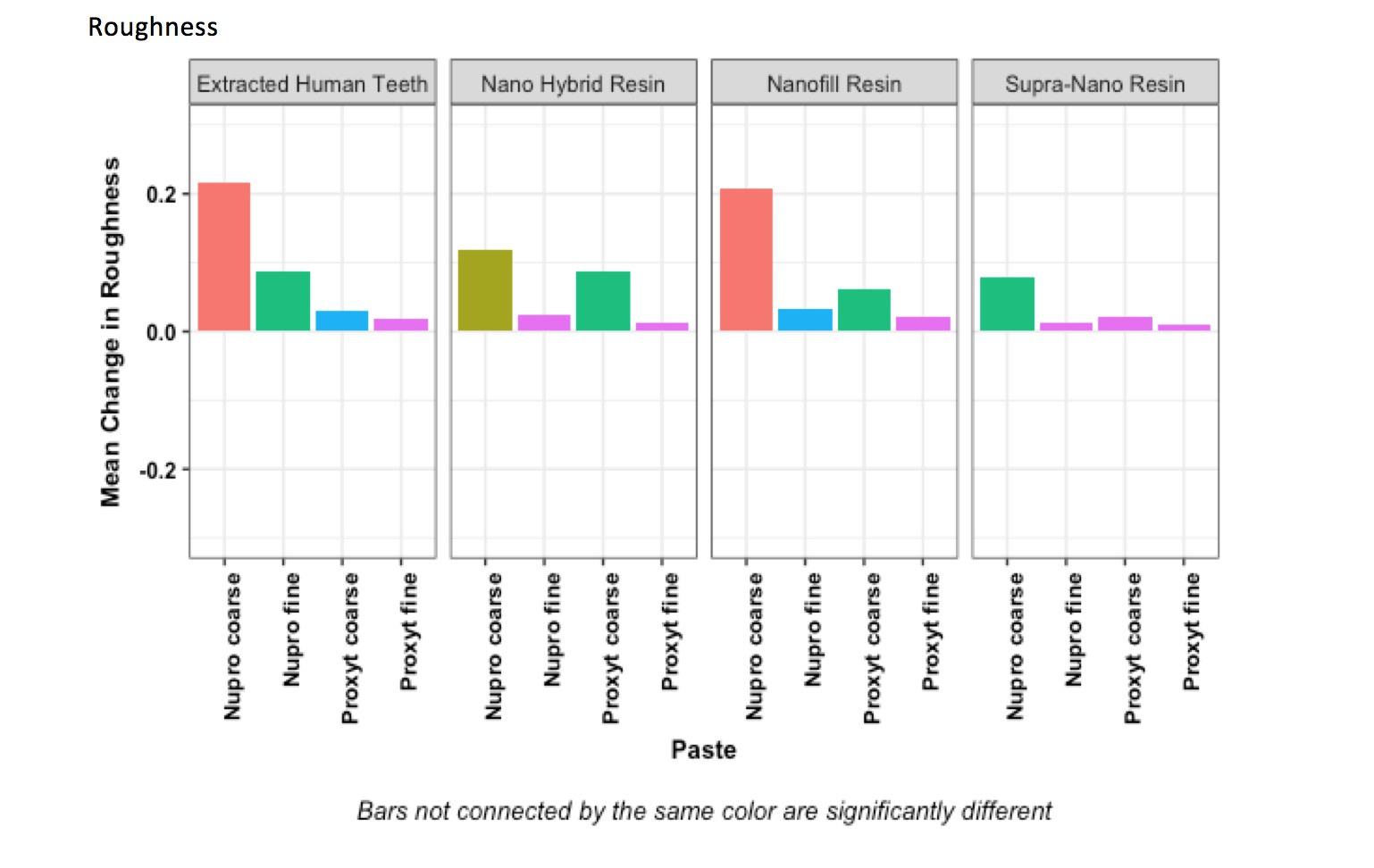IADR Abstract Archives
Effect of Prophylactic Pastes on Surface Roughness of Resin Composites
Objectives: To evaluate the effect of prophylactic pastes on the surface roughness of three commonly used resin composites and human enamel.
Methods: A total of sixty specimens, composed of three types of composites were prepared to test the hypothesis. Twenty disk shape (2x14mm diameter) specimens were assigned to each group: Nano-hybrid (NH) (IPS Empress Direct, Enamel A2, IvoclarVivadent), Nano-filled (NF) (Filtek Supreme, A2, 3M/ESPE), and Supra-nano (SN) (Estelite Omega, A2, Tokuyama). They were polymerized under Mylar strips using LED light (VALO 1,400 W/cm2) and finished/polished gradually down to 1,200 grit size. Specimens were ultrasonically cleaned and dried. Four intact human enamel surfaces (E) served as a control group. Baseline surface roughness was measured with a Profilometer (Veeco Dektek 150, Plainview, NY) from 3 spots on each specimen. Five specimens from each group were randomly assigned to one of the four groups of the following prophylactic polishing pastes with different grit sizes: Proxyt Coarse/Fine (PC/PF) (Ivoclar Vivadent), Nupro Coarse/Fine (NC/NF) (Dentsply). They were applied to the specimens by a calibrated/blind operator using un-impregnated prophylactic cups according to the manufacturers’ instructions for 40s (10-second intervals) under a constant load of 400gr at 3,000rpm. Surface roughness of the specimens were re-measured. A mixed, general linear model was used for statistics, and significance was accepted at p <0.05. Post-hoc comparisons were conducted using Tukey test.
Results: No significant difference was found by composites [F(3, 48) = 5.82, p = 0.001, η2 = 10%]. A significant difference was found by prophypaste [F(3, 48) = 31.26, p < 0.001, η2 = 51%], and a difference between the interaction of composite by paste [F(3,48) = 2.57, p = 0.016, η2 = 13%]. Reviewing the effect size estimates (η2) indicates that prophylactic pastes had the greatest effect on roughness. (Table 1) (Figure 1)
Conclusions: Nupro Coarse had a significant effect on all composite resins and human enamel. While the remaining prophylactic pastes had less impact, with Proxyt Fine showing the least effect on the roughness of all groups. This increased surface roughness ultimately leads to higher plaque retention, reduced esthetics, gingival irritation and decreasing the longevity of the restorations.
Methods: A total of sixty specimens, composed of three types of composites were prepared to test the hypothesis. Twenty disk shape (2x14mm diameter) specimens were assigned to each group: Nano-hybrid (NH) (IPS Empress Direct, Enamel A2, IvoclarVivadent), Nano-filled (NF) (Filtek Supreme, A2, 3M/ESPE), and Supra-nano (SN) (Estelite Omega, A2, Tokuyama). They were polymerized under Mylar strips using LED light (VALO 1,400 W/cm2) and finished/polished gradually down to 1,200 grit size. Specimens were ultrasonically cleaned and dried. Four intact human enamel surfaces (E) served as a control group. Baseline surface roughness was measured with a Profilometer (Veeco Dektek 150, Plainview, NY) from 3 spots on each specimen. Five specimens from each group were randomly assigned to one of the four groups of the following prophylactic polishing pastes with different grit sizes: Proxyt Coarse/Fine (PC/PF) (Ivoclar Vivadent), Nupro Coarse/Fine (NC/NF) (Dentsply). They were applied to the specimens by a calibrated/blind operator using un-impregnated prophylactic cups according to the manufacturers’ instructions for 40s (10-second intervals) under a constant load of 400gr at 3,000rpm. Surface roughness of the specimens were re-measured. A mixed, general linear model was used for statistics, and significance was accepted at p <0.05. Post-hoc comparisons were conducted using Tukey test.
Results: No significant difference was found by composites [F(3, 48) = 5.82, p = 0.001, η2 = 10%]. A significant difference was found by prophypaste [F(3, 48) = 31.26, p < 0.001, η2 = 51%], and a difference between the interaction of composite by paste [F(3,48) = 2.57, p = 0.016, η2 = 13%]. Reviewing the effect size estimates (η2) indicates that prophylactic pastes had the greatest effect on roughness. (Table 1) (Figure 1)
Conclusions: Nupro Coarse had a significant effect on all composite resins and human enamel. While the remaining prophylactic pastes had less impact, with Proxyt Fine showing the least effect on the roughness of all groups. This increased surface roughness ultimately leads to higher plaque retention, reduced esthetics, gingival irritation and decreasing the longevity of the restorations.

